Getting a cactus home is a great place to start when it comes to indoor plants as these succulents require very, I repeat very, little care.
Regardless of whether you are new to indoor plants or a cactus aficionado, they make a perfect addition to your house, especially the cute ones!
They come in varied sizes, colors, and patterns. In fact, there are over 2000 different kinds of cacti in the world, and placing them in your living room will give it a nice exotic touch.
Now, while these beauties require little maintenance, it is important to remember not to ignore the care altogether.
There are three key factors that you need to check when it comes to cacti— soil with good drainage, sufficient sunlight, and a good potting mix.
If you’re a newbie to this whole indoor plant scenario then you might have some preconceived notions about plants in terms of watering and sunlight.
Not all plants require daily watering (especially a desert plant like the cacti) and lots of sunlight (3-5 hours of sunlight is also sufficient).
Table of Contents
What are the top 10 cutest cacti?
- Old Lady Cactus (Mammilaria hahniana)
- Bishop’s Cap (Astrophytum myriostigma)
- Moon Cactus (Gymnocalycium mihanovichii)
- Christmas Cactus (Schlumbergera)
- Fairy Castle Cactus (Acanthocereus tetragonus)
- Feather cactus (Mammillaria plumosa)
- Bunny Ears Cactus (Opuntia microdasys)
- Ladyfinger Cactus (Mammillaria elongata)
- Barrel Cactus (Echinocactus grusonii)
- Star Cactus (Astrophytum asterias)
1. Old Lady Cactus
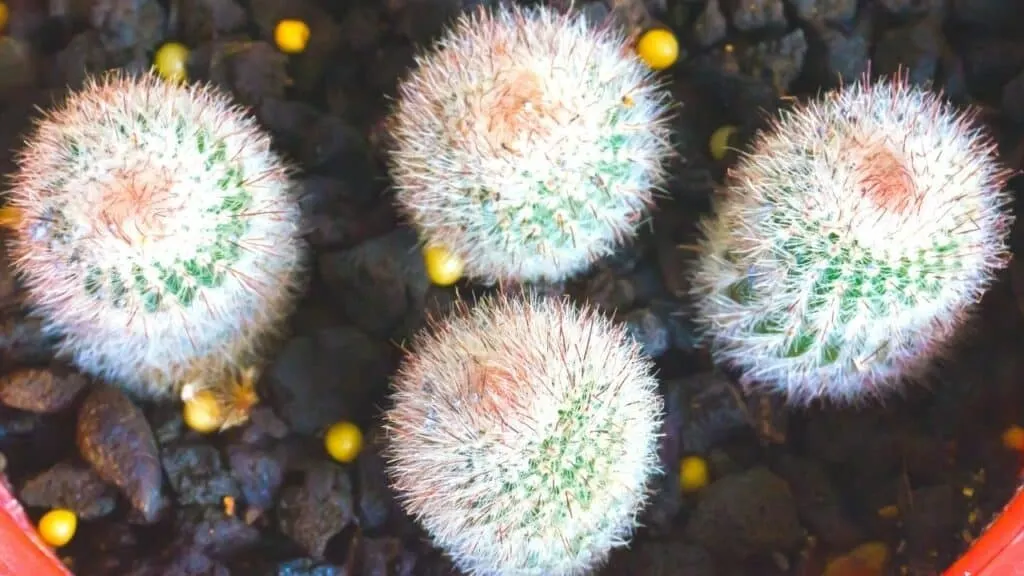
A fluffy white ball of joy is what the old lad lady cactus looks like—a collection of spherical stems that are covered in sharp white spines. Reddish-purple flowers blossom during the spring and summer on the top of the plant.
Native to Central Mexico, the Old Lady Cactus is a nearly threatened species. Compared to other cacti on the list, they require a little extra care(just like old ladies do!).
They need at least 4-6 hours of direct sunlight, safeguarded from heat waves as well as cold drafts. On the plus side, this plant doesn’t need a lot of water, so you can water it once every 10-14 days when kept indoors, especially during the summer months.
Just a reminder, if the cactus doesn’t get enough water it will start turning yellow. Also, I recommend that you use a low nitrogen fertilizer during the growing season to keep the cactus healthy and fresh!
2. Bishop’s Cap
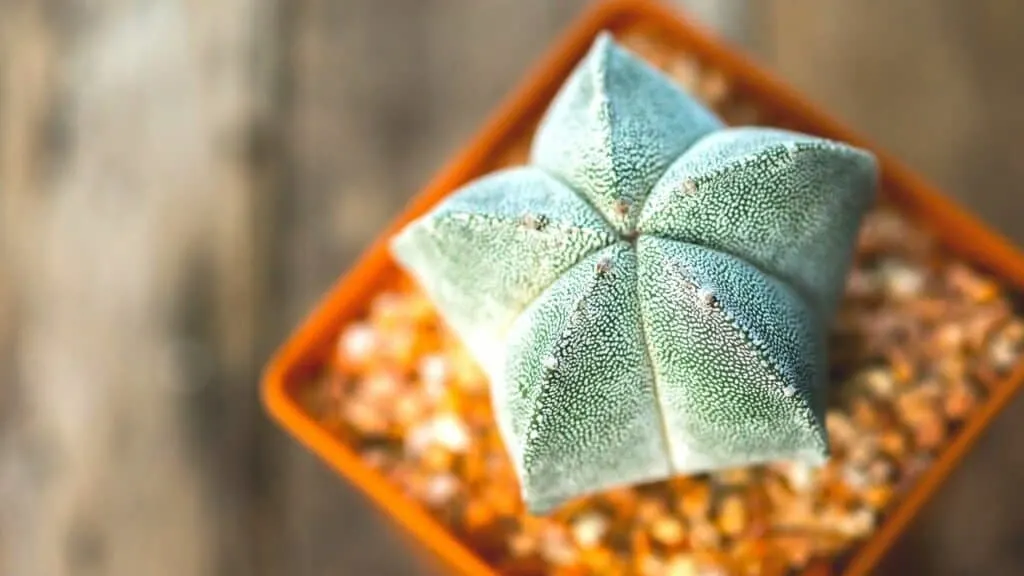
Also known as Bishop’s Hat or Bishop’s Miter Cactus, the Bishop’s Cap Cactus is a spineless, star-shaped cactus (Top view) that bears a cute little single daisy-like flower at the center of the star.
Generally, the plant usually has 5 ribs, giving it a star-like appearance, and has tiny white hairy scales on its stem, and grows to be about 3 feet (1 m).
As this cold-hardy cactus originates from Northern and Central Mexico, it can survive even at 21℉ (-6℃) but they require some amount of direct sunlight and for best results should be given light shade and a well-draining pot to survive.
The Bishop’s Cap needs some periodical watering during summer, while you should try to avoid overwatering during the winter months.
Just as other Cacti, this one also requires a low nitrogen fertilizer to grow faster and I suggest, even though it might not be an absolute rule, you should use some amount of fertilizer during the growing season to keep the plant in good health.
As always, remember to keep the plant in a well-draining pot, because Cacti don’t like staying in the water.
3. Moon Cactus
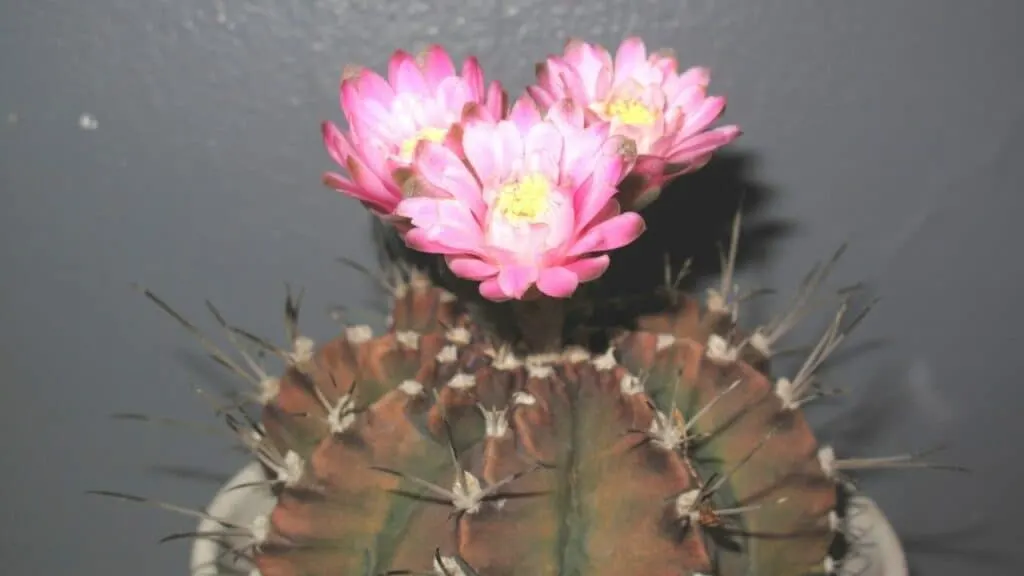
The Moon Cactus is native to various parts of South America and comes in vibrant bright colors of hot pink, brilliant orange, and neon yellow.
These are small plants and grow to be about ½ inch (1 cm.) across, although there are some that grow up to 8 inches (20 cm) in diameter.
Also known as Hibotan cactus, these succulents prefer warm temperatures and need at least 48℉ (9℃) to survive.
Use a proper draining mix and a shallow pot with many drainage holes to prevent water stagnation.
During summers you can water the plant 2-3 times a week as for winters you can water once a week.
Pro tip—wait for the soil to completely dry out before watering again.
4. Christmas Cactus
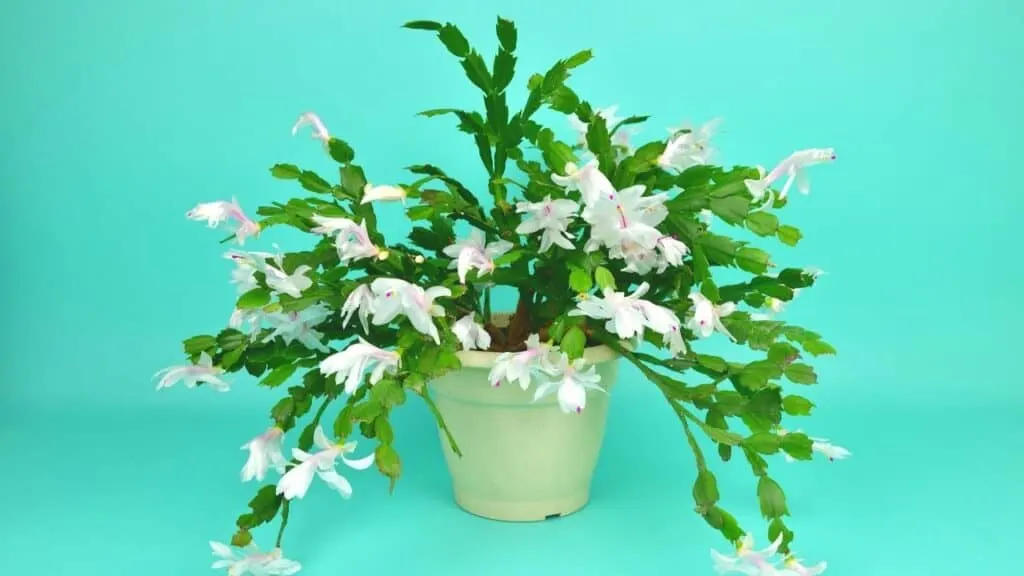
Easter cactus, Thanksgiving cactus, or the Christmas Cactus is one of the few cacti that bloom in winter, unlike other cacti that grow in summer or spring.
With the beautiful red, white-yellow, pink, or purple flowers blooming during the holiday season, this cacti gets its well-known name of Christmas Cactus and will be a gorgeous addition to your room decor.
Originating from coastal regions of Brazil, this is also one of the tropical cacti that favor humid climates, unlike the dry desert cacti.
Also due to being moisture-loving cacti compared to all other cacti on this list, this fella likes to be in a little moist environment, thus resulting in frequent need of water.
But do not over-water it or else the roots will rot and the leaves may turn yellow.
In terms of sunlight, this one prefers some shade contrary to others, hence I suggest you put it somewhere near an east-facing window. A moderate amount of high potassium fertilizer will help in blooming once the buds appear.
Here’s a tip—You can use a potting mix rich in hummus and remember not to overwater the plant—just keep the soil moist.
5. Fairy Castle Cactus
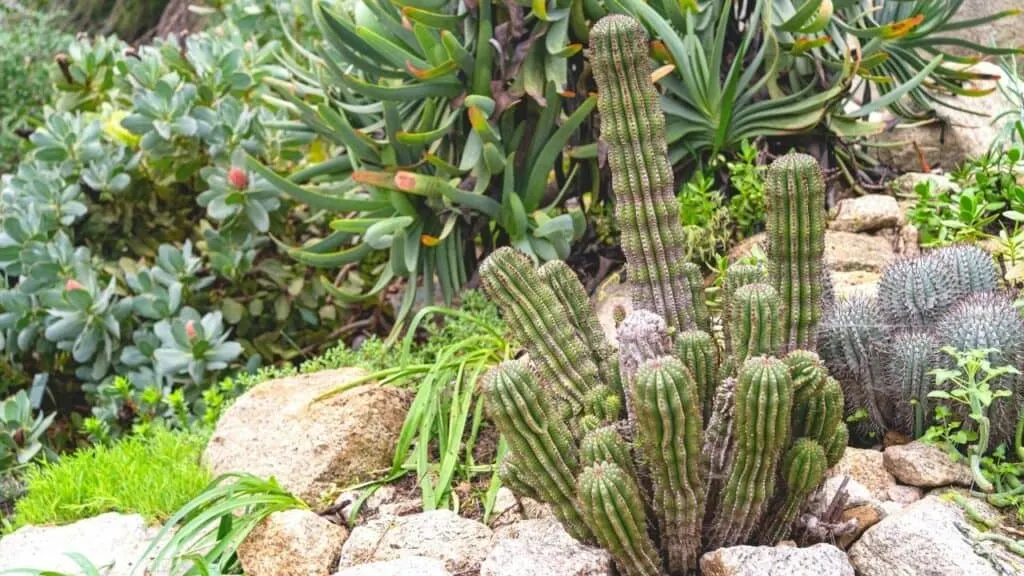
Native to America, they are categorized in USDA hardiness zones 10a to 11b. The most common indoor-grown cactus, the Fairy Castle Cactus is basically a bunch of vertical stems resembling spires and turrets.
These cacti require very little maintenance and are a great place to start indoor gardening.
The Fairy castle cactus is a popular choice simply because it is an extremely cute looking cacti and is easy to look after—just keep it in temperatures ranging 25°-50°F(-4° to 10° C) and water only when the soil is dry. Overwatering is usually the reason why cacti get damaged.
This is one of the outdoor plants which can be kept indoors. It does need a good potting mix, gritty soil, and dry weather as well as infrequent watering to survive.
And with its long maturity period and slow growth, it takes about 10 years to reach 6 feet of height. Just like other cacti, the Fairy Castle Cactus too needs proper drainage to thrive.
It is important to keep in mind that the Fairy Castle Cactus requires to be kept in a well-lit environment where there is ample sunlight available and away from cold drafts.
6. Feather Cactus
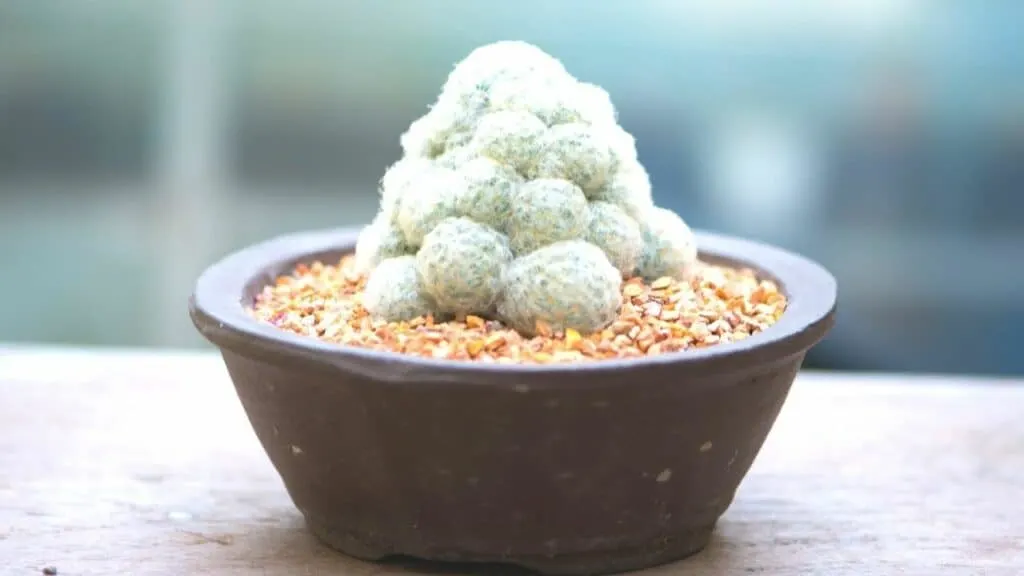
The Feather Cactus is often described as a ‘cluster of clouds’. Yes, it is white, looks cute, is fluffy, and has a bunch of clustered balls!
The fluffy look of the Feather Cactus comes from the closely packed white spines which bend after a certain length. However, always remember that even though the old and outer spines are bent and blunt, there are sharper and thinner new spines just under them.
Also originating from Mexico, they grow to be 3inches (8 cm) tall and 16 inches (40.6 cm) wide. Just like other cacti, they also need full sun to partial shade to be healthy and can be watered daily during summer.
But keep in mind that water does not collect on the topsoil or else the excessive water will rot the roots. It is winter dormant but not cold hardy. They can survive at 21°F(-6℃), but it is necessary to keep it in a well-drained pot.
7. Bunny Ears Cactus
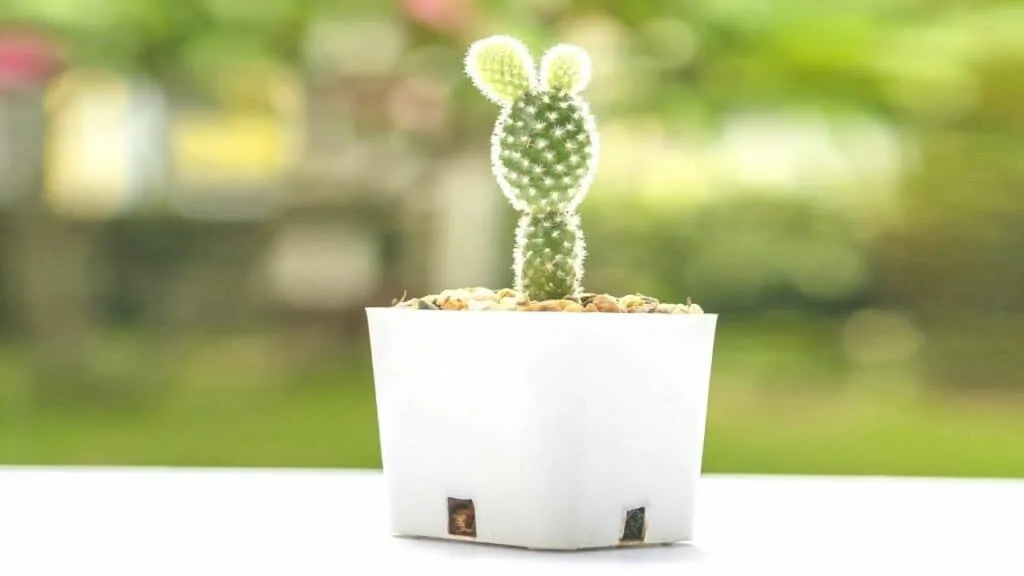
Also called Angel’s wing cactus or Polka-Dot Cactus, the Bunny Ears Cactus is arguably one of the cutest cacti on the list, if not the cutest.
The new segments of the plant always grow in pairs like that of angel’s wings or bunny ears and thus the name! This cactus bears creamy yellow flowers and purple fruits and is a great addition to your indoor plants’ collection or a great start at it.
Originating in Mexico, this cactus grows on arid land and thus requires direct sunlight, arid potting mix, higher temperature, and less water.
It is ideal to water this plant when the top layer of the soil is dried up, and usually, it takes up to 5 days.
But during the winter season, this cactus can be watered once every 3-4 weeks depending upon the condition of the topsoil. The most important part of keeping this little guy happy is to have a well-draining pot, as stagnant water will rot the roots.
During the growing season, I prefer to use fertilizer diluted with water to spray on the plant as it requires more nutrition during the growing Summer season.
Pro tip— Too much fertilizer can harm the plant, thus, it is necessary to use the right amount of fertilizer. Preferably 1 teaspoon of fertilizer mixed in 2 liters of water.
8. Ladyfinger Cactus

The Ladyfinger Cactus has a slow growth rate and grows to be up to 8 inches (20 cm) tall and 12 inches (30.5 cm) wide. They are not cold hardy, so keep them indoors if you live in cold areas.
One of the very low maintenance cacti, this Mexican cactus can survive in sunny spots as well as partial shades, and it doesn’t even require much fertilization.
It is necessary to water this cactus once or twice a week, depending upon how the climate is and most importantly whether the soil is dry or not.
They can be propagated using stem cuttings—just cut an elongated stem from the parent plant and let it be callous for a few days before you plant it in well-draining soil.
9. Barrel Cactus
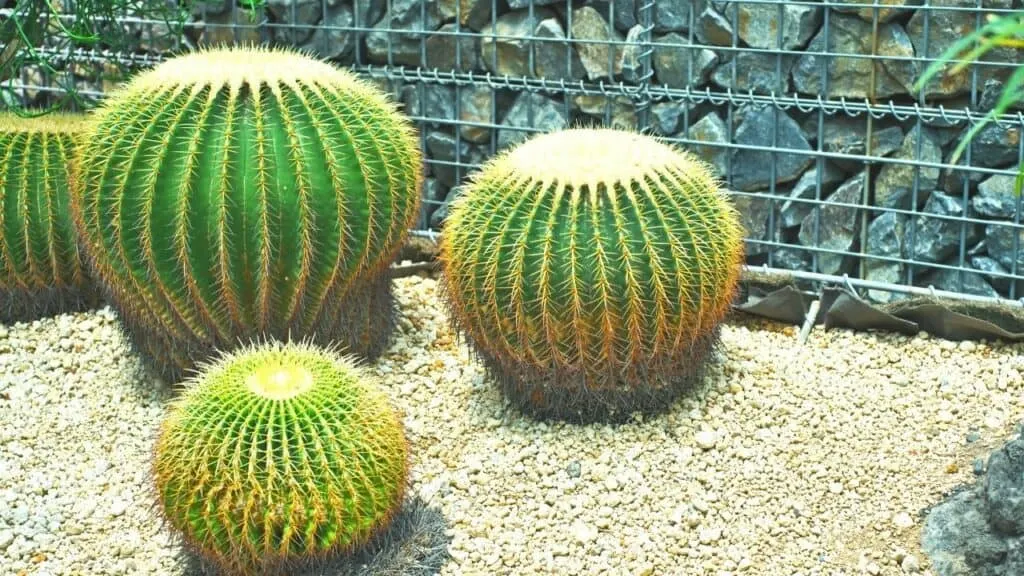
The golden and white spines of this cactus and the ball shape give it a charming vibe and make for a cute addition to your room.
Originating from America, an arid soil cactus, this little guy requires a lot of sunshine and less water. It is very important to understand that if not enough sunlight is provided, this cactus’ growth will stagnate.
They do not require much water so you can water them twice a month but feel free to use a fertilizer that has high potassium content for better growth in summer.
The soil for this cactus is composed mostly of sand, with a little topsoil, perlite, and compost.
Always remember not to overwater a cactus, that’s kinda the only thing that kills cacti.
Fun fact—The Barrel Cactus acts as a guide for travelers in the desert as they habitually tilt towards the southwest.
10. Star Cactus
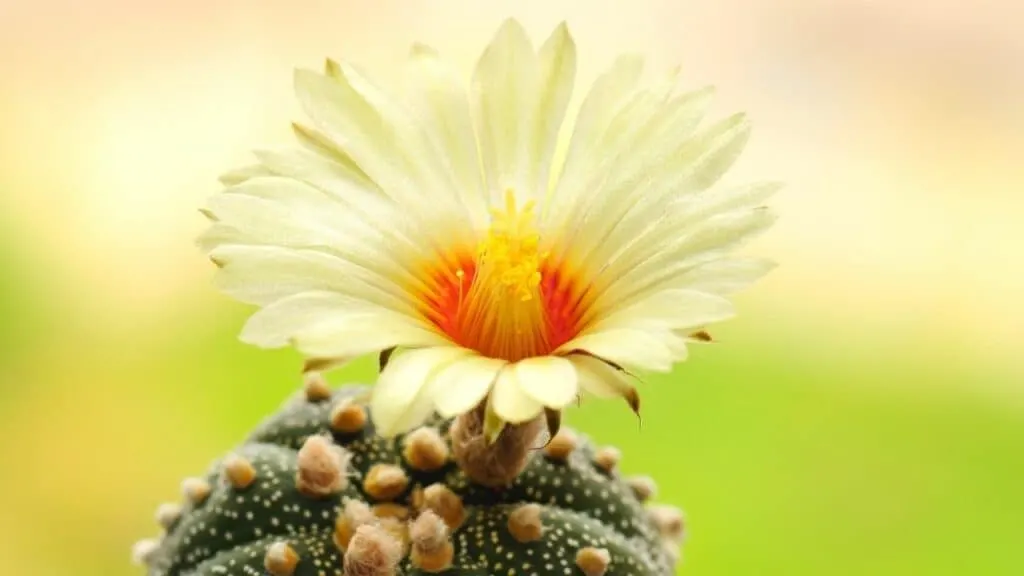
Astrophytum Asterias simply looks like a star—it has the word ‘astro’ in the scientific name in itself. Even though it is stated to be a vulnerable species and might cost a bit of money, this cute plant has a chubby round body that resembles a sand dollar. They make for a pretty addition to your succulent collection.
This little guy originates from America and they need a lot of sunlight to grow properly hence, it is necessary to place them in such a position so that they can get an adequate amount of sunlight throughout the day.
But keep in mind that the star cactus does not react too well to heatwaves. However, it does need occasional watering and will flatten and decolor if it has a water deficiency; but that is only during summers.
In winter the plant lays dormant and doesn’t need water at all. Having a good fertilizer with high phosphorus and low nitrogen helps in the healthy growth and vibrant looks of the cactus, but it is not necessary unless it’s summer.
Frequently Asked Questions about Cacti
Can all cacti be kept indoors?
No, even though most small cacti can be kept indoors, but larger ones aren’t supposed to be indoors as they require much more space and sunlight. Place one or two on your window sill and watch them add to your home decor!
How much care does a cactus need?
Not a lot, to be honest. Cacti are low maintenance plants compared to any other type of plant. They, however, do require water when the soil is dry along with sufficient sunlight and fertilizer during the summer months.
Can a cactus survive without water?
Not really, all cacti are plants and do need water to survive, but not as much as other plants.

Daniel has been a plant enthusiast for over 20 years. He owns hundreds of houseplants and prepares for the chili growing seasons yearly with great anticipation. His favorite plants are plant species in the Araceae family, such as Monstera, Philodendron, and Anthurium. He also loves gardening and is growing hot peppers, tomatoes, and many more vegetables.


